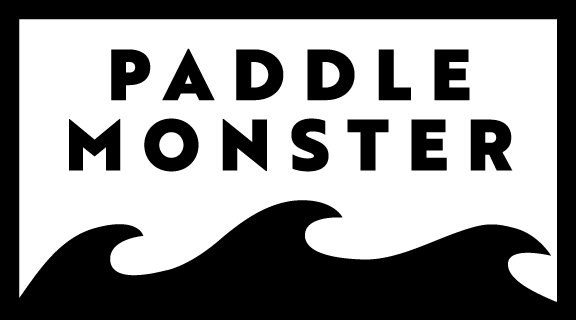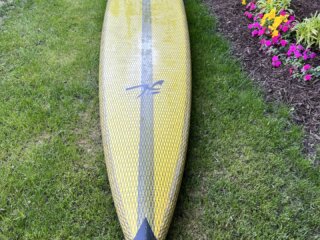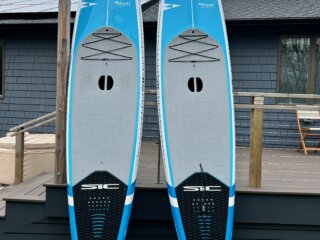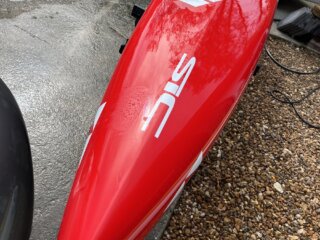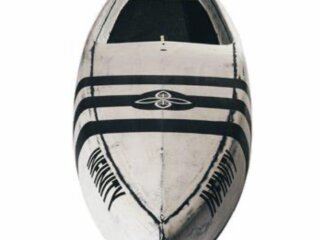
By Bruce Kirkby
Editor's Note: This is a special contribution to Paddle Monster from Bruce Kirkby, recounting his Hectate Straight crossing with Norm Hann.
In June 2023, after years of planning and training, Norm Hann and I became the first to cross Canada’s legendary Hecate Strait by paddleboard.
Separating the islands of Haida Gwaii from the British Columbia’s northern coast is the notorious Hecate Strait. The site of strong winds, massive tidal currents, frequent storms and shallow waters, Environment Canada ranks Hecate as the most dangerous body of water on the Canadian coast - and the fourth most dangerous in the world. John Vaillant, author of The Golden Spruce, puts it this way: “The Strait is a malevolent weather factory. During winter storms, waves can reach 10-20m and expose the sea floor. The result is one of the most diabolically hostile environments that wind, sea and land are capable of conjuring up.” For mariners, Hecate holds a fearsome reputation; it’s the site of many tragedies and much suffering.
Generations ago, the Haida First Nation crossed the Strait in great cedar canoes. Carved from single logs, these boats were up to 60 feet long, 6 feet wide and capable of carrying 100 men, and they allowed the Haida to pillage other coastal nations with impunity, then disappear back across Hecate’s moody waters, where none dared follow.
But the recent history of human powered Hecate crossings is scant. Masset kayaker Chris Williamson made two attempts in the 90’s; one successful, the other time he was turned back at night by changing winds. Legendary painter Stewart Marshall from Sointula Island, sailed a homemade kayak 200 nautical miles across Queen Charlotte Strait and Hecate in a SE storm, surviving for three days on popcorn and coffee before finally arriving at Cape St James. In 2008, a group of four young Haida Gwaii men crossed in double sea kayaks as part of a fundraiser. But Google ‘Hecate kayak crossing’ and you won’t find much. In the years since Hilary and Tenzing climbed Everest, 12,000 climbers have stood on that elusive summit. But in the same span, only a handful have paddled across Hecate. And no one had crossed the dangerous waters by paddleboard.
I met Norm Hann at the Whistler World Ski & Snowboard Festival in 2016, where we were both presenting about past adventures. Sharing a paddleboarding background, we became fast friends. Norm was a successful racer who had transitioned to long coastal journeys. I had recently paddled solo around the outside of Vancouver Island. When Norm casually asked if I’d be interested in trying to paddle across Hecate with him, my reply as an unflinching “YES!”
We began planning, training and watching weather. The next spring we drove to Prince George, with hopes of carrying on towards Haida Gwaii, and tackling Hecate. But as one storm after another crashed into the BC coast, we reluctantly turned around. Thank goodness - because in hindsight, we weren’t ready. Not even close.
For the next five years, as we continued to watch Hecate’s weather patterns, we tackled increasingly challenging SUP expeditions together; retracing a Gitgat Grease Trail in the Great Bear Rainforest, rounding Cape Scott, Brooks Peninsula, and Cape Caution. As our wilderness SUP experience and skills grew, so did our trust and teamwork.
At the same time, I had begun working with Coach Larry Cain, initially to refine my paddling efficiency and technique, and then year-round to build fitness, endurance and speed. Year by year I saw the average speeds I was able to maintain on a loaded SUP board creep upwards.
In the summer 2023, we planned a journey traversing the northern BC coast, both aware that if the stars aligned, and a weather window appeared, we’d drop those plans and hightail it to nearby Haida Gwaii, in the hope of trying an attempt on Hecate.
It was late May when Norm and I met at his home in the sleepy hamlet of Royston on Vancouver Island, and drove to Port Hardy, where we had reservations on the 7am ferry. Sleeping in the back of my pickup, I awoke at 3am to the sound of Norm retching over the tailgate. We cancelled our ferry reservations. For the next 24 hours Norm couldn’t even take a sip of water. What was it? Food poisoning? COVID? Flu? Should we turn back? Did it make sense to start such a journey depleted?
Two days later, with Norm feeling marginally better, we boarded the 18-hour ferry to Prince Rupert. Long after midnight we landed, and with rain pelting down, we pitched a tent in a dark corner of the BC Ferry parking lot. Listening to the marine weather forecast on our VHF radio, we discovered the frontal system lashing the North Pacific was clearing. And before the fair-weather gales that frequent the Canadian coast in summer built again was a tiny window of ‘light and variable’ winds. Tine was against us, but if we could get ourselves in position to launch in 24 hours, crossing Hecate might just be a possible
The next morning, we boarded the fabled ‘vomit-comet’, for a seven-hour ferry ride to Haida Gwaii. As the ship chugged on, we called every friend and contact we knew on the islands - but no one was able to drive us to the launch site that evening. We both knew if we weren’t on the beach by nightfall, and ready to launch at dawn, a similar weather window might not appear again for months. Or years.
In desperation, we began canvassing fellow ferry passengers - and eventually found Harmonie Rose; a delightful free spirit who helped lash our 14’ paddleboards to the roof of her tiny KIA, then raced off the ferry the moment it docked. Driving us to the northerly outpost of Masset, she deposited us with Thor Collison, Head of North Beach Rescue, and one of very few with the skills to drive Haida Gwaii’s soft, sprawling beaches. The sun had dropped into the Pacific and darkness was descending as Thor left Norm and I on the lonely shores of Rose Spit. At last Hecate lay before us; grey and moody. The next morning at dawn, we would launch.
Few words were shared in the mute light of dawn as we strapped waterproof bags to our boards, attached compasses, and double-checked GPS way points. Then we were off. With a brisk west wind at our back, there would be no turning back once we launched - the only way out would be through.
The first hour passed like a dream; gusty winds pressed us over smooth waters, and we covered 7.5km - which for fully loaded boards felt great. Then Hecate began to show us who she really was. Swell built from the north, hitting us on our rear quarter, and we had to concentrate to stay upright. Then the ebb tide turned to flood, and currents swirled around us. Soon an aggressive wind chop arrived from the south, mixing with the swell and turning the ocean into a confused mess. Our progress slowed to 5 kilometers per hour. Then 4. Then a painful 3.5.

The minutes and hours crawled past. Despite paddling side by side, we spent a lot of time alone with our thoughts. I struggled not to think about our speed or progress - for it was dishearteningly slow. The time (and suffering) remaining seemed unconquerable. Instead I focused on taking just one more good stroke. Then another. Then another. Snacks and gulps of water were stolen between strokes. We never stopped paddling.

On those lonely waters, we saw nothing save a few gulls; not a single whale nor boat. Gradually the distant peaks of Stephen’s Island inched closer. 20km to go. Then 10. Dusk had descended by the time we neared shore. We’d been paddling for 11 hours, and it took us another hour to find a spot to land along the rocky headlands. When we finally crawled ashore, neither of us was able to walk in a straight line, or form complete sentences. After getting a tent up, we cooked a freeze-dried meal, then collapsed into sleeping bags, overjoyed. The dream we’d held for so long, that often felt impossible and improbable, had been realized. And we both knew we couldn’t have done it alone.

With the weight of Hecate lifted, we found ourselves free to enjoy the remote outer islands of the North Coast. Stephen Island was marked by craggy headlands, where shattered white rocks rose sheer from the ocean, while hidden in deep bays layochre-sand beaches and ancient village sites. Neighboring Porcher Island was completely different; low-lying and massive, its vast outer beaches were composed of pebbles, the size and shape of marbles, and equally as colorful.

Day after day, we pressed southwards, passing occasional humpbacks, watching eagles soar on afternoon breezes. A week later, we ducked into the tiny First Nation settlement of Kitkatla, grabbed a boat back to Prince Rupert, and began the long voyage home.

Paddle Events
DeSatnick Foundation Around the Cape Paddle
Ohio River Paddlefest Races
The Circumnavigation-Tilghman Island 2024
Recent Classifieds
Custom Hobie 14′ SUP
- Sell
- 3 days ago
- Stand Up Paddleboard
- Virginia Beach , Virginia United States
- 51 views
2 Boards: Both SIC Bullet 12’6″ x 28.5″
- Sell
- 1 week ago
- Stand Up Paddleboard
- 02813 Charlestown , Rhode Island United States
- 107 views
SIC XRS 14 x 22
- Sell
- 2 weeks ago
- Stand Up Paddleboard
- Chattanooga , Tennessee United States
- 142 views
Wanted! Ocean / downwind 14 foot SUP
- Buy
- 2 weeks ago
- Stand Up Paddleboard
- Main Street , 07005 Boonton , New Jersey United States
- 125 views
one edge pro 2.0 hollow 14′ x 23.5”
- Sell
- 2 weeks ago
- Stand Up Paddleboard
- 53066 Oconomowoc , Wisconsin United States
- 161 views
Subscribe for Premium Content and Coaching
Join the Paddle Monster paid Plan Today!
You May Also Like


The Island Paddler: How (and Why) I Became a Voyager

